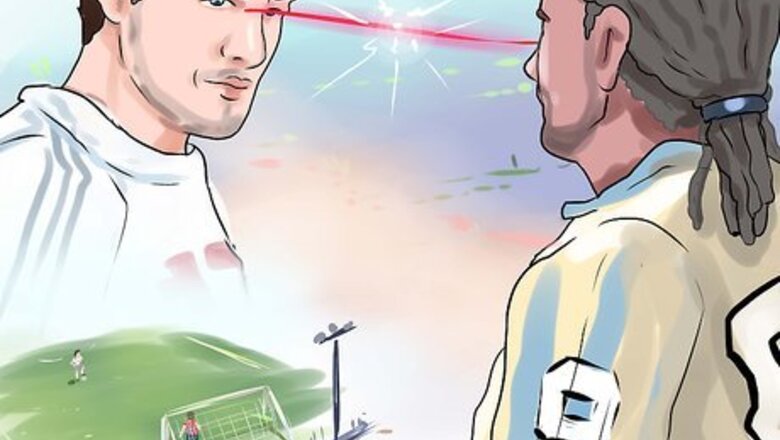
views
Reading the Shot during the Game
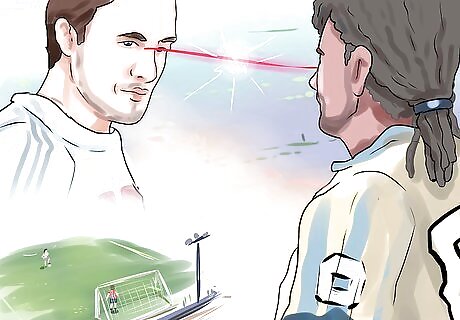
Watch the shooter’s eyes. Before a shooter makes his penalty kick, he’ll likely size up the situation and decided on a direction in which to take his shot. Watching the shooter’s eyes can cue you in to where he plans to kick the soccer ball. If a shooter continually looks at a certain area of the goal, this could be where he intends to kick the ball. A shooter’s eye may also give smaller clues. For example, if he looks up to the sky, then he is likely going to kick the ball high between the goal posts. Professional players will also use their eyes as a way to fake out a goalie so she or he jumps in the wrong direction. For this reason, look at other cues like body positioning.
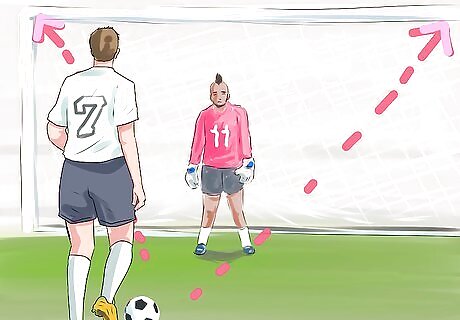
Watch the kicker’s approach towards the goal. Is it coming directly at you or wide from the side? By watching how a kicker is approaching the goal, you can gather valuable clues about direction in which he will kick. If a kicker approaches from the side, it often indicates that he will kick towards the opposite corner of the goal. If the kicker is coming directly at you, however, it is more difficult to read where he will shoot because it is easier for him to pivot and shoot in different directions from this approach.
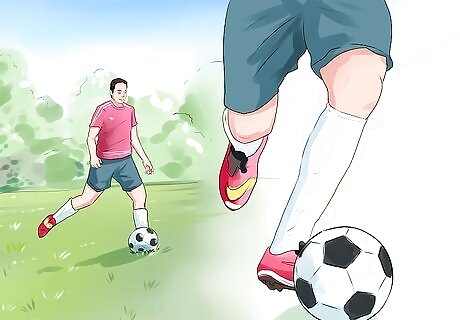
Watch body positioning. Just like the eyes, how the kicker positions his body will likely cue you in to where he intends to kick. Since body positioning is more obvious than the eyes, this may be an easier way to read penalty shots for new or less experienced goalies. Watch the kicker’s plant foot. The plant foot is the foot with which the player does not kick, but rather “plants” into the ground. The ball will follow the trajectory towards which the plant foot points. Watch the kicker’s hips. Since the hips can’t usually go in a different direction than the feet, the ball will also follow the direction of the kicker’s hips. Watch the kicker’s head. Looking at the kicker’s head can also give you clue about the direction he intends to shoot the ball. If he drops his head and then pulls back his leg, this usually indicates a cross-body shot. On the other hand, if the kicker holds his head straight, it may mean he will shoot the ball to the opposite corner.
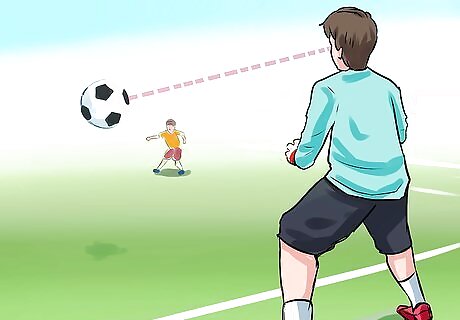
Watch the ball. If you’re a goalie with fast reflexes or even want to work on your reaction time, watching where the ball goes after it is kicked is another way to read penalty shots. This is a riskier and less reliable tactic than reading the player, but sometimes it’s your only option. Following the ball is called reactionary defending. It requires that you not only have good reflexes but also confidence in your skills to follow the ball after the shooter kicks it. If you can watch the ball and the player’s body positioning, which will require some practice, you are more likely to save the ball.
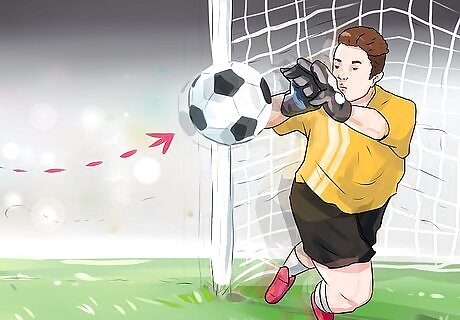
React to the ball. Once a kicker has made a shot on goal, you need to react to the play based on the clues you’ve gathered from watching the player’s body positioning and the ball. How you react depends on where the ball is traveling. Always commit to the play no matter what happens. Hesitation will cause you to make mistakes, including letting the ball in to the goal. If the ball is kicked low, dive in that direction and catch it with your hands. If the ball goes high, you’ll want to jump instead of diving. You can also opt to punch the ball outside of the goal area if it is too high to catch. If there are a lot of the opposite team’s defenders in the goal area and you need to clear the ball quickly, kick it out as far as you can. Make sure to always keep your eyes on the ball so that you don’t accidentally lose it. You want to react quickly, but not too quickly. Because penalty kicks are often weaker shots, a goalkeeper can often save the ball if they wait and simply react to the shot.
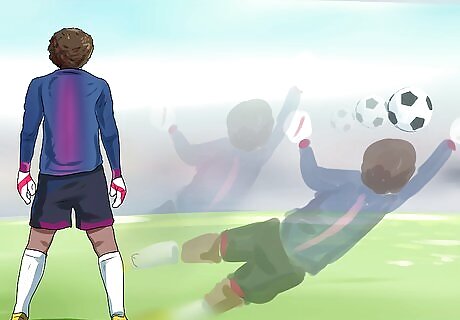
Use your instincts. Part of reading penalty shots is inherently instinctive. As you become a more experienced player, you’ll be able to anticipate where penalty kicks are going more effectively. But even if you’re a newer player, using your instincts for plays can be beneficial to your team. Don’t discount your instincts when anticipating shots on goal. Your brain may be catching subliminal and subtle cues and sending them to you as a “gut reaction.”

Use optical illusions to your benefit. Recent studies have shown that goalies can use optional illusions to influence the accuracy of penalty shots. This tactic can ease the work of reading a kicker or the ball. Stand off center. One study has shown that by standing marginally to one side of the goal will influence the perception of the kicker to kick to the side with more open. But this allows the goalie to strategically dive to this in order to save the ball. Making yourself larger in the goal will also throw off a penalty kicker. For example, if you hold your arms up in the air, the kicker will perceive you as larger and the goal smaller, which will plant a kernel of doubt in his mind about the ability to make the goal.

Talk to your teammates. There is usually a quick pause before any penalty shots are taken. Use this time to your benefit by asking your teammates if they’ve noticed any patterns in the kicker’s play that would help you to anticipate where or how he will kick.
Researching Players before the Game
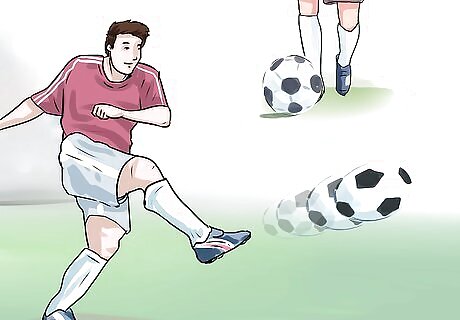
Know the penalty shot statistics. The general tendency of a kicker is to shoot the ball opposite the goalie. Knowing this tendency can help you more effectively anticipate where a kicker will shoot the ball. One study showed that almost 70% of penalty kicks taken went to the side opposite the kicker's dominant foot: right-footed players kicked to their left and the keeper's right and vice versa. This mimics the natural swing of the foot across the body because it is difficult to shoot to the opposite corner using an instep kick. If you can’t read the player or the ball, it’s best to assume that you should go right for a right-footed kicker and left for a left footer.

Study the opposite team before the match. Just as it’s important to pay attention to the other team’s players during the game, it’s also wise to study them before you meet them on the field. This will give you an idea of how they generally play and also highlight any playing patterns by individual players. Watch videos of the other teams matches to acquaint yourself with their playing style. If you are near your opposing team or cannot get a video of them playing, visit one of their games. Studying the motions of a player on a computer can also improve your ability to read the movements a shooter makes because these give away clues about how they will play.

Learn about kinesiology. Knowing how to anticipate any body’s movement is something that can help any goalkeeper defend shots on goal. By learning the principles of kinesiology, or the study of movement, you can become a much more effective goalie, especially against penalty kicks. Most colleges offer courses in kinesiology, though you can also find online courses at places like the University of Utah or Sam Houston State University.














Comments
0 comment